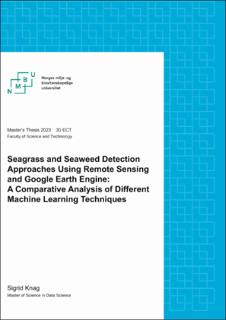| dc.contributor.advisor | Hovedveilderer: Fadi al. Machot | |
| dc.contributor.advisor | Habib Ullah | |
| dc.contributor.author | Knag, Sigrid | |
| dc.date.accessioned | 2023-07-12T16:27:16Z | |
| dc.date.available | 2023-07-12T16:27:16Z | |
| dc.date.issued | 2023 | |
| dc.identifier | no.nmbu:wiseflow:6839521:54591690 | |
| dc.identifier.uri | https://hdl.handle.net/11250/3078353 | |
| dc.description.abstract | Seagrasses and seaweed habitats contribute to crucial ecological services globally, from
capturing carbon dioxide and supporting 20% of the world’s largest fisheries to sustaining
the small, but many coastal communities [1]. Across the globe, an alarming decline in
their wild distribution has been recorded, attributed to climate change and direct pollution
[2]. Current estimates of how much the loss is are uncertain and mapping and monitoring
efforts are costly, data-intensive, and lack scalability. Thus, freely available data and
software in remote sensing, coupled with Machine Learning (ML) are deemed important
means to leverage existing mapping of seagrasses and seaweed spatial distribution [3, 4].
This thesis explored a free and scalable workflow by comparing three different ML
techniques mainly on Overall Accuracy (OA) and Tau(e) in classifying seagrass, seaweed,
and water. These are supervised, unsupervised, and semi-supervised learning (SSL) which
used data from the satellite, Sentinel-2 Level-2A, applied to a novel area of study, from
Biddeford Pool to Small Point at the Coast of Maine, United States of America. Results
showed that the SSL achieved the highest OA of 76% and Tau(e) = 0.72 on the hard test,
in line with previous work. To the best of the author’s knowledge, this work contributes
to the field of science by being the first in its field to use the geospatial analysis package
’geemap’, along with the software Google Earth Engine, and SSL for classifying seagrass
and seaweeds. Through demonstration, this work shows the potential of free data in remote
sensing, leveraged by ML to aid community monitoring in the environmental management
of seagrass and seaweed. The results here can be considered as a starting point for further
exploring the SSL paired with freely available data and community monitoring to lower
costs, handle data scarcity, and scale up in the field of aquatic vegetation mapping and
monitoring. | |
| dc.description.abstract | Seagrasses and seaweed habitats contribute to crucial ecological services globally, from
capturing carbon dioxide and supporting 20% of the world’s largest fisheries to sustaining
the small, but many coastal communities [1]. Across the globe, an alarming decline in
their wild distribution has been recorded, attributed to climate change and direct pollution
[2]. Current estimates of how much the loss is are uncertain and mapping and monitoring
efforts are costly, data-intensive, and lack scalability. Thus, freely available data and
software in remote sensing, coupled with Machine Learning (ML) are deemed important
means to leverage existing mapping of seagrasses and seaweed spatial distribution [3, 4].
This thesis explored a free and scalable workflow by comparing three different ML
techniques mainly on Overall Accuracy (OA) and Tau(e) in classifying seagrass, seaweed,
and water. These are supervised, unsupervised, and semi-supervised learning (SSL) which
used data from the satellite, Sentinel-2 Level-2A, applied to a novel area of study, from
Biddeford Pool to Small Point at the Coast of Maine, United States of America. Results
showed that the SSL achieved the highest OA of 76% and Tau(e) = 0.72 on the hard test,
in line with previous work. To the best of the author’s knowledge, this work contributes
to the field of science by being the first in its field to use the geospatial analysis package
’geemap’, along with the software Google Earth Engine, and SSL for classifying seagrass
and seaweeds. Through demonstration, this work shows the potential of free data in remote
sensing, leveraged by ML to aid community monitoring in the environmental management
of seagrass and seaweed. The results here can be considered as a starting point for further
exploring the SSL paired with freely available data and community monitoring to lower
costs, handle data scarcity, and scale up in the field of aquatic vegetation mapping and
monitoring. | |
| dc.language | eng | |
| dc.publisher | Norwegian University of Life Sciences | |
| dc.title | Seagrass and Seaweed Detection Approaches Using Remote Sensing and Google Earth Engine: A comparative Analysis of Different Machine Learning Techniques | |
| dc.type | Master thesis | |
